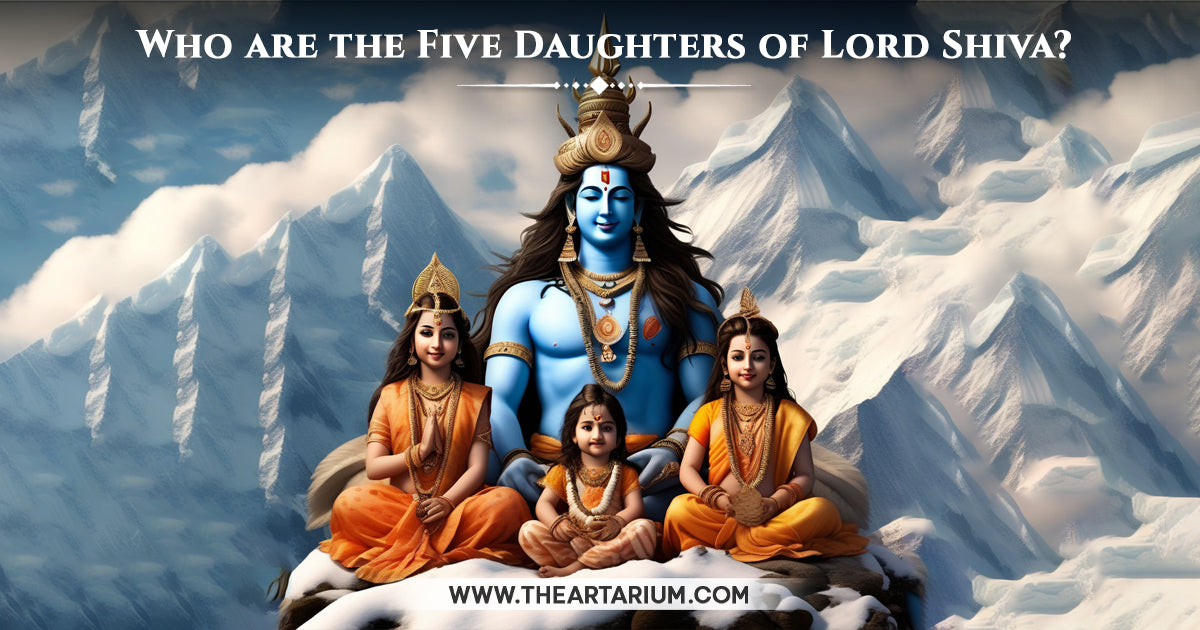The Five Daughters of Lord Shiva A Divine Legacy
 Nikhil Raikwar
Nikhil Raikwar
Lord Shiva, one of the principal deities of Hinduism, is renowned for his profound spirituality and supreme power. While much of the focus in Hindu mythology centers on his consort Parvati and their sons, Ganesha and Kartikeya, there is also a fascinating aspect of his divine lineage that often goes unnoticed—the five daughters of Lord Shiva. These celestial beings embody various virtues and contribute to the rich tapestry of Hindu mythology.
The Origin and Significance
The five daughters of Lord Shiva, known as the "Panchakanya" or "Five Virgins," are revered figures in Hindu tradition. They are often depicted as embodiments of purity, strength, and divine grace. Each daughter is associated with a unique set of attributes and stories that highlight her role in the cosmic order.
1. Ganga: The Sacred River
Ganga, the daughter of Lord Shiva, is perhaps the most well-known among his daughters. She is personified as the sacred river Ganges, which holds immense religious significance in Hinduism. According to legend, Ganga was originally a celestial river flowing in heaven. To purify the earth, she descended to the mortal realm.
Lord Shiva, recognizing the immense power of Ganga, caught her in his matted hair to prevent the forceful descent that could have devastated the earth. By doing so, he allowed Ganga to flow gently, providing blessings and purification to all who bathe in her waters. Ganga represents purity, cleansing, and divine grace.
2. Yamuna: The Serene River
Yamuna, another daughter of Lord Shiva, is personified as the Yamuna River. Like her sister Ganga, Yamuna is also a sacred river, revered for her divine significance. She is intimately associated with the life and exploits of Lord Krishna, who spent his childhood in the region along the Yamuna River.
Yamuna is known for her serene and nurturing qualities. The river symbolizes the flow of divine love and the sustenance of life. Her connection with Krishna highlights her role in providing a divine setting for many of his leelas (divine pastimes).
3. Saraswati: The Goddess of Wisdom
Saraswati, the third daughter, is the goddess of wisdom, knowledge, and arts. She is often depicted playing the veena (a musical instrument) and is revered as the patroness of learning and creativity. Saraswati is associated with purity and enlightenment, embodying the divine intelligence that guides and inspires scholars, artists, and musicians.
In her role as the goddess of knowledge, Saraswati plays a crucial part in the spiritual and intellectual development of humanity. Her wisdom transcends the boundaries of the material world, guiding individuals towards self-realization and spiritual awakening.
4. Lakshmi: The Goddess of Prosperity
Lakshmi, the fourth daughter, is the goddess of wealth, prosperity, and good fortune. She is commonly depicted with four arms, symbolizing the four goals of human life (Purusharthas): dharma (righteousness), artha (prosperity), kama (desire), and moksha (liberation).
Lakshmi's association with wealth and prosperity makes her a central figure in various Hindu rituals and festivals, such as Diwali. She is also the consort of Lord Vishnu, and her blessings are sought for material and spiritual abundance.
5. Durga: The Warrior Goddess
Durga, the fifth daughter of Lord Shiva, is a powerful and revered goddess known for her strength and valor. She is depicted with multiple arms, each holding a weapon, symbolizing her ability to combat evil and protect righteousness.
Durga is celebrated for her role in the triumph of good over evil, particularly in the festival of Durga Puja. Her fierce and protective nature contrasts with the more serene attributes of her sisters, showcasing the multifaceted nature of divine feminine energy.
The Cultural and Spiritual Impact
The five daughters of Lord Shiva, each embodying different aspects of divinity, hold a special place in Hindu culture and spirituality. They are not merely mythical figures but represent various aspects of life and the universe.
Ganga and Yamuna symbolize the sacredness of natural elements and their role in sustaining life and spirituality.
Saraswati represents the pursuit of knowledge and wisdom, crucial for personal and societal growth.
Lakshmi embodies prosperity and well-being, highlighting the importance of material and spiritual abundance.
Durga illustrates the power to overcome challenges and maintain cosmic order.
Together, they offer a holistic view of divine feminine energy, demonstrating the diverse and interconnected roles that different aspects of the goddess play in the cosmic order.
Conclusion
The five daughters of Lord Shiva—Ganga, Yamuna, Saraswati, Lakshmi, and Durga—are integral to Hindu mythology and spiritual practice. Each goddess brings a unique dimension to the divine narrative, emphasizing the multifaceted nature of the divine feminine daughters of Lord Shiva. Their stories and attributes continue to inspire and guide devotees, offering lessons in purity, wisdom, prosperity, and strength.
In exploring these divine figures, one gains a deeper appreciation for the richness of Hindu mythology and the profound ways in which it reflects the complexities of existence and the divine.
Subscribe to my newsletter
Read articles from Nikhil Raikwar directly inside your inbox. Subscribe to the newsletter, and don't miss out.
Written by
